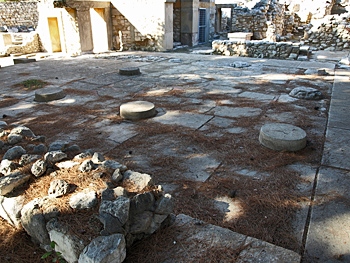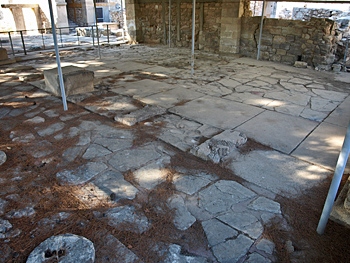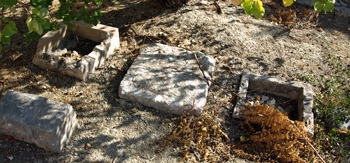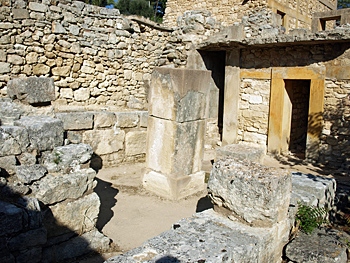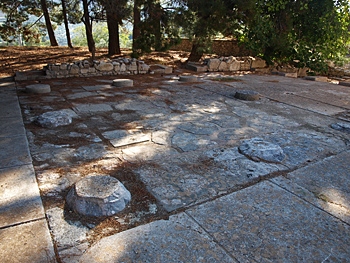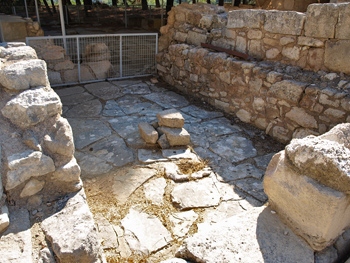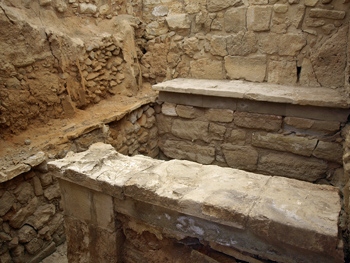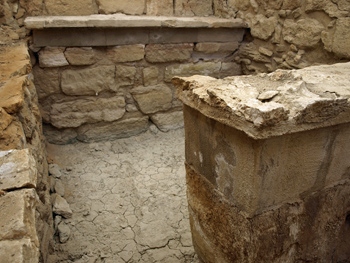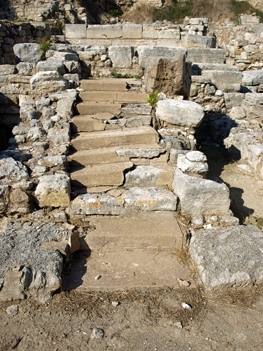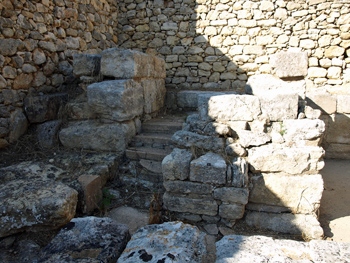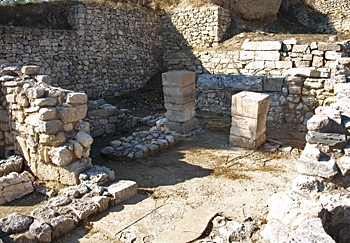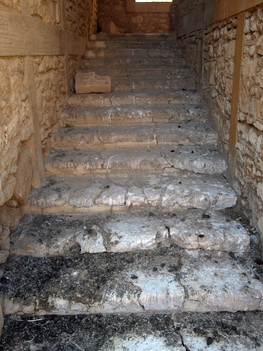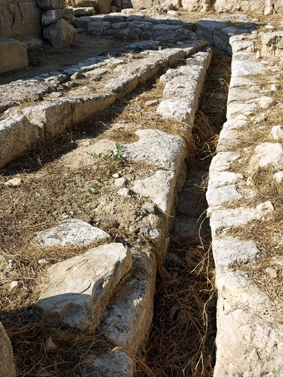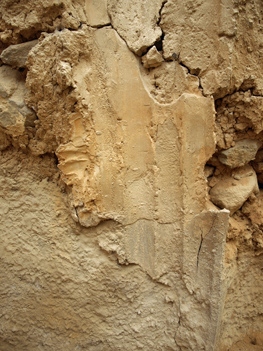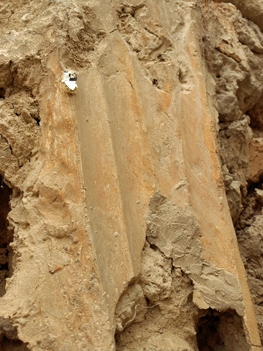The excavation of the Little Palace
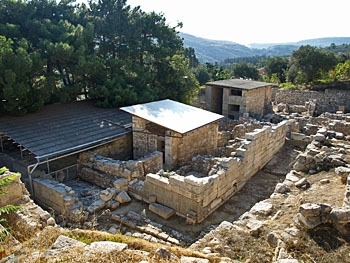
The Little Palace showing the west facade, the
Minoan Hall (front left covered area), the lustral basin (front right covered area) and the
staircase (back covered area)
The Little Palace is located about 200 metres north west of the Palace of Knossos, to the east of the Unexplored Mansion to which it was once joined by a bridge. The Little Palace was constructed first and it was built on three levels, a basement, ground floor and upper floor.
Arthur Evans began excavations at the Little Palace in 1905. He undertook restoration work, not unlike that he carried out at the Palace, in order to protect certain parts of the building from collapse or decay. The most important room in need of protection was the Lustral Basin (room 17) because of the remains of the fluted columns (see photos below), but he did not limit himself solely to this area and when he started using concrete and iron girders in the palace, he used them extensively here too. In 1956 Platon carried out further preservation work and conservation work last took place at the site in 1995 under the direction of Alexandra Karetsou. The Little Palace has been so heavily reconstructed that it is bears little resemblance to what was actually excavated. It is therefore interesting to see photos taken of the site immediately after it was uncovered. A large number of such photos can be found in the book Knossos: The Little Palace by Eleni Hatzaki, on which much of the content of this page is based.
The history of the Palace
The area where the Little Palace is located was already densely populated in the Middle Minoan period so it is not surprising that a building had already existed on the site before the Little Palace. The most significant remains are of a building with monumental features including what has been called the Early Facade. This is similar to the remains of the West Facade of the Old Palace at Phaistos and an argument can be made that this building went out of use in MM IIIA, at the very beginning of the Neopalatial period.
The Little Palace was constructed in the Neopalatial era with a north-south orientation similar to the building it replaced. Although the Little Palace, with its Minoan Hall, lustral basin, pillar crypts and gypsum staircases, is not unique among elite buildings outside the Knossos Palace, what does make it unique is its size. It had thirty-seven rooms on the ground floor alone. The Little Palace was almost certainly designed and built as a single structure and its architectural plan seems not to have undergone any major change until its final destruction in LM IIIA, although it underwent a lot of rebuilding during its lifetime.
Early on in the life of the new building the famous bull's head rhyton was buried in space 35. Rehak suggests that it may have been intentionally damaged before disposal, in which case it may have been placed in the foundations of the new building.
It isn't known if the Little Palace had been completed when work began on the adjacent Minoan Unexplored Mansion. However, what is known is that the bridge that was constructed to link the two buildings together necessitated modifications to the west facade of the Little Palace in order to create an entrance into the building from the bridge. The Minoan Unexplored Mansion was almost certainly built to provide extra storage, work and accommodation areas for the Little Palace. There is no Minoan Hall or lustral basin in the Minoan Unexplored Mansion.
The next major development to happen at the Little Palace is thought to have coincided with the earthquake on Thera which preceded the volcanic eruption in LM IA. This earthquake caused damage to a number of buildings on Crete, including the Little Palace. Rebuilding seems to have taken place at this time and the lustral basin was filled in here as happened elsewhere on Crete during LM IA. (At the Unexplored Manion, by contrast, construction work seems to have come to a halt and it seems to have remained empty throughout the LM IB period). Because there are no LM IB deposits at the Little Palace it is not known if the building was reoccupied after the repairs were carried out. But it has been argued that the building was cleared for further rebuilding and repairs in LM IIIA1 and this may account for the absence of evidence of an LM IB occupation.
No pottery has been found at the Little Palace from the LM II period, which causes problems of interpretation. There seems to have been a major LM II destruction horizon at Knossos. The Little Palace underwent major repair in the LM IIA1 period, and again it seems likely that the LM II layers would have been cleared away as part of the rebuilding process, hence accounting for the absence of pottery from that period. The rebuilding work in LM IIIA1 altered circulation patterns in the building and most dramatically eliminated the Minoan Halls. One interpretation of the changes made at this time is that there was an attempt to bring into the Little Palace some of the facilities from the now severely damaged Unexplored Mansion.
The Little Palace was destroyed in LM IIIA2 in an extremely fierce fire which baked some Linear B clay tablets and a large number of clay sealings. It is assumed that they had fallen from an upper floor. The ferocity of the fire could be due to the amount of wooden beams used in the construction of the Little Palace as well as the nature of the contents being stored there at the time. It is thought that the fire was deliberately set and that the Little Palace was also looted. All the finds reported by the excavators of the Little Palace had fallen from the upper floor. The Linear B tablets and over 100 sealings were found fallen into eight different rooms. The presence of these tablets of course attest also to the presence of Mycenaeans, who had at any rate been present at Knossos from LM II onwards.
After its destruction by fire in LM IIIA2, the Little Palace was once again reoccupied, as evidenced by the presence of LM IIIB pottery excavated by Evans, in particular from the less damaged south west corner of the building. The building was then finally abandoned in LM IIIB at much the same time that the reoccupied parts of the Palace and surrounding houses were abandoned.
There now follows a more detailed description of some of the rooms in the Little Palace. Arthur Evans gave names to many of the rooms he excavated, which are included here along with the room numbers.
The basement
The basement was set three metres lower than the ground floor and consists of three rooms. Two of these contain square pillars. There were also two staircases, one of which was reconstructed by Evans to give access to the basement.
Room 1: The room of the three pillars
This room takes up almost half of the basement and would have been entered from room 3, the room of the two pillars. Evans actually reconstructed the three pillar bases now seen in this room even though the excavators could only be sure of one pillar. There was some evidence for a second pillar and the third base was constructed because a sense of symmetery suggested to Evans that it should be there.
Room 2: The South West Staircase
The staircase at the south west corner of the basement (see photo below) was one of two staircases giving access to the basement. Three gypsum steps were found to still be in place. Access to the staircase was from room 3, where there is a gypsum threshold but the evidence from the doorjambs shows that access to room 3 was controlled from the stairs, not from the room. The doorjambs were also constructed of gypsum.
Room 3: The room of the two pillars
This room and therefore the basement as a whole, was entered from either the south west staircase or the reconstructed north staircase (staircase 4). There are two pillars in the room. The south one is complete, but only the foundation block remains of the north pillar. Between the two pillars there is a limestone cist.
The Eastern Sector
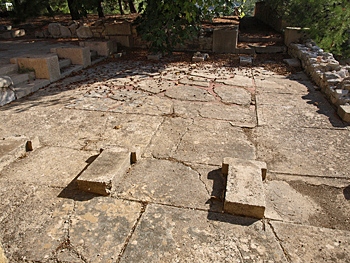
The Hall of the Stepped Doorways photographed
from Corridor 6a. A reconstruction of the stepped
doorways can be seen top left
The eastern facade of the Little Palace is completely missing and reoccupation of the site in later times severely damaged the rooms in this part of the building. Nevertheless a very impressive suite of rooms remains. These include the Minoan Hall (rooms 8, 9 and 10) to the north, while another group of rooms to the south would have been equally impressive. These would have consisted of the badly destroyed and heavily restored rooms 6a and 6b, which are the only ones that remain, and other rooms which would have been above the basement. Between these two groups of rooms is another heavily restored area, room 7, now known as the Peristyle Hall, the largest room on the ground floor. Room 7 was entered through pier-and-door partitions from both the north and south. Rooms 6a and 6b were constructed some 20cm lower than room 7 and so two gypsum steps were placed at the entrance to the doors in the pier and door partitions. All these rooms are examined in more detail below.
Room 6a: The corridor west of the Hall of the Stepped Doorways
Room 6a was in effect a corridor giving access from the main entrance to Rooms 7 and 6b. The corridor was originally paved with gypsum slabs, most of which have now been cemented over.
Room 6B: The Hall of the Stepped Doorways.
Not much has survived of this room and much of what we see today is Evans' reconstruction of the room. It would have been similar to the rooms in the Minoan Hall both in size and quality of construction. It could be entered from three directions, the corridor to the west (room 6a), the room over the basement to the south and the Peristyle Hall to the north.
Room 7: The Peristyle Hall
The Peristyle Hall is the largest room on the ground floor. The Hall is sited at a central point in the building and is accessible from all directions. Its most impressive feature is the square Peristyle which originally consisted of eight round columns. Only four survive, three along the west side and one next to the north west corner pillar (see photo) Again it was reasons of symmetery that led Evans to propose eight pillars around a square court in the middle.
Some of the original ironstone paving inside the central square is still in place, held together by cement added by the excavators. Evans considered this central paved area to have been an open-air court. However no way of draining away rain water has been found. The floor surrounding the Peristyle and in the area between the Peristyle and Rooms 6A and 6b were paved with gypsum.
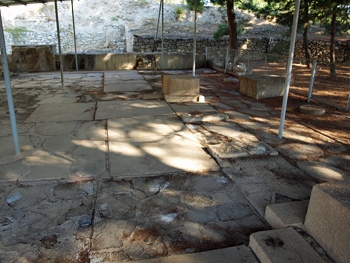
Minoan Hall showing pillar bases for portico, (room
10) right, then a row of pier and door partitions giving access to the Minoan Hall itself. (Room 8
foreground, room 9 behind)
Rooms 8, 9 and 10: The Minoan Hall
The Minoan Hall, or the Minoan Megaron as Evans preferred to call it, is found at the north end of the eastern sector and comprised two rooms, (rooms 8 and 9) which opened to the east onto a columned porch -- a covered area that was nevertheless open on the eastern side (room 10).
Room 8 is surrounded by pier and door partitions on three sides giving access to room 9, to the covered porch (room 10) and to the Peristyle Hall. Many of these partitions had to be replaced in their original positions by the excavators. On the west side of room 8 stands an original wall. Some traces of the original mud plaster used in the construction of the wall can still be seen. This wall would originally have been lined with dado slabs.
Room 9 is smaller than room 8 and its north wall was much reconstructed using rubble and cement. It has also been lined with a dado of gypsum which was added during restoration work. It is not known what this wall would originally have looked like. The central area of the floor was paved with ironstone slabs to form a rectangle and these were surrounded with gypsum slabs to complete the flooring.
The north and south ends of the porch (room 10) are missing but it almost certainly extended the whole length of rooms 8 and 9. It was paved with ironstone slabs.
A small number of fragments from Linear B tablets were found in the Minoan Hall and also in the Peristyle Hall. It is likely that they had fallen from the upper floor during the destruction of the building. Given the small number of fragments it cannot be said with certainty whether there was an archive maintained within the Little Palace or whether these are simply pieces that found their way into the Little Palace. Certainly at the time of the destruction of the north and east sectors there was no large archive being maintained at the Little Palace.
Room 11: The Lavatory
This room lies to the north of the building and an outlet from the room connected with the north drain which passed outside the north wall of the room. The only entrance is in the south-east corner of the room which links to room 9. The floor was paved with ironstone slabs, most of which remain in place. Far from being unique, a number of Minoan toilets have been uncovered at sites across Crete.
The North Sector
Several large rooms and a maze of smaller ones make up the North Sector. By far the most interesting is Room 17, the lustral basin also known as the Fetish Shrine
Room 17: The Lustral Basin or Fetish Shrine
The lustral basin is a square area 1.20 x 1.20 metres, with a floor lower than the adjacent rooms. On three sides of the room there are gypsum balustrades. The entrance to the room leads directly to gypsum steps down into the lustral basin. There is some evidence of fire damage in the room which is thought to have occurred after the lustral basin had been filled in and the floor level raised. The north wall, next to the steps was covered with a gypsum dado, above which patches of mud plaster used to coat the wall are still visible.
The balustrade on the east ran the whole length of the room. In the area above the balustrade the gaps between the pillars were originally open so the Lustral Basin was visible from the corridor to the east. In the Neopalatial period these open areas between the pillars were filled in to form a wall. The gypsum ledge contained three sockets for wooden column bases, long since rotted away. The mud plaster placed behind these columns now bears the impression of these pillars (see photos below). The interesting thing is that the impression of the "fluting" is concave, which means that the "fluting" on the original pillars was convex, the complete opposite of what is normally seen on pillars in, for example, the Greek period, and not seen anywhere else in Minoan Crete.
Various kinds of finds were uncovered in Room 17. It now seems to be generally accepted that they fell from the upper floor during the fire and destruction of the Little Palace. 1) Four natural stone concretions, with a fifth found in room 19 next door, were found in various positions. These are basically pieces of natural rock, possibly formed in a similar way to stalagmites, (four of sandstone and one of limestone). They may have seemed to the Minoans to resemble the human form, although in one or two cases it is hard to see how. Although it is not known when they were placed there, they were still a focus of worship right up until the destruction of the Little Palace in LM IIIB. 2) Some animal figurines which are now missing so little can be said about them. 3) Horns of consecration were found broken in the room and the original excavators believed that they had been broken by rubble falling from above, but it seems more likely that they, too, fell from the upper floor. 4) A lead female figure with arms upraised in the style of LM IIIB and LM IIIC clay female figurines was also found. But various aspects of the figurine including the gesture itself, the Minoan skirt and the hairstyle all suggest LM I rather than LM III.
Numerous sealings were also found in Room 17 and Room 19. They too had fallen from above and because they were baked in the fire of the fire destruction they provide a date for the Fetish Shrine. There may have originally been over 120 sealings but over a hundred have been lost and all that remains are sketches of 51 of them. Of the sealings from the Little Palace still in existence, each has just one seal impression and all but two are what are known as string sealings. This means that originally that were made around "string" of leather, gut or fibre. The seals were then tied to the objects that they were sealing. Most of the examples of string sealings were found deliberately broken. This suggests that goods were arriving at the Little Palace and being stored on the upper floor.
The Central Sector
Rooms 28, 29, 30: The Magazines
Evans decided that these three rooms must have been magazines based presumably on their shape and their position within the building. All three rooms were accessed from a single door, opening from Room 31. A narrow corridor then passes the entrances to each of the three rooms.
Room 31: The Light Well
This room, which also provides the entrance to the storage magazines, was identified by the excavators as a light well. As it would also have allowed rain to fall, one would expect to find a drain, but there does not appear to be one. The room does however occupy a central position in the building.
Room 32: The Main Staircase
The condition of the main staircase deteriorated rapidly after it was excavated so that Evans decided to rebuild the structure using rubble and cement. However, the lower flight of stairs, consisting of 14 gypsum steps, is original. The upper flight of steps had collapsed and Evans restored most of the steps to their original position.
Staircase 34: The West Staircase
The lower flight of the West Staircase remains much as it was. The staircase not only led to the upper floor but it also gave access to the bridge which joined the Little Palace to the Unexplored Mansion to the East. (For photo see above left)
The South West Sector
Room 36: The South West Pillar Room
This room was entered from the South West Court. Inside there were two pillars lining up north-south. The base of the pillars is of gypsum while the pillars themselves are of limestone. The pillars had been damaged and so the excavators restored them with concrete. It's role as a pillar crypt has been questioned. (For photo see below)



